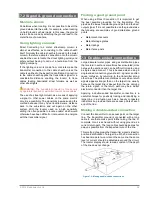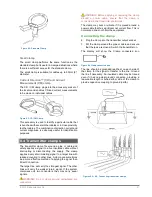
© 2015 Radiodetection Ltd
25
Section 6 - Depth and current readings
6.1 TruDepth
™
The RD8100 locator provides automatic depth of buried
cables, pipes and sondes and when the locator is
correctly orientated above the target line or sonde.
Current readings are also displayed simultaneously if the
locator is orientated correctly (feature not available in
sonde or passive frequency modes).
Depth and current readings are automatically displayed
simultaneously, but if the locator is not correctly
orientated neither reading will be displayed.
Depth range and accuracy vary depending on the
makeup and type of target utility (e.g. cable, pipe or
sonde), its depth and external environmental factors like
electromagnetic
noise,
ground
conditions
and
interference.
WARNING: The accuracy of depth measurement is
subject to a number of factors and is meant as a guide
only. Never use the depth measurement to define
mechanical digging depths. Always follow local safe
digging guidelines.
The depth measurement is to the center of the pipe,
cable or sonde. The best readings are typically detected
from
‘active’ signals output by a transmitter rather than
from passive sources.
The RD8100 locator is capable of determining cable
depth when locating some passive power signals.
However passive signals on lines are less suited for
measuring
depth
because
accuracy
can
be
compromized by interference- e.g due to the passive
signal being present on more than one line.
WARNING! Do not make depth measurements near
bends or tees in the line. Go at least 5m (16ft) from a
bend for best accuracy.
TruDepth for buried conductors or
sondes
TruDepth and Compass
It is important to note that the RD8100 locator will only
display depth and current (in applicable modes) when
the locator is correctly orientated above the target line,
cable or sonde. To ensure the locator is correctly
orientated, use the Compass feature.
When locating lines, make sure the Compass display is
in the North / South orientation position.
When locating sondes (see Section 8.5), make sure the
Compass display is in the East / West orientation.
Figure 6.1: Taking a depth reading
To minimize signal distortion, do not apply the signal by
induction. If Direct Connection or signal clamping is not
possible, place the transmitter in induction at least 15m
(50ft) from the point of any depth measurements.
Depth measurements may not be accurate if there is
audible interference or if part of the transmitter signal has
coupled to a nearby line.
Confirming the Peak position coincides with a Null
position indicates that the position is suitable for making
a depth estimate.
Figures 6.2: Depth readings
Pinpoint the target line accurately with the locator
Check the locator is directly over the line, the
antennas are at right angles to it and the locator is
vertical. Adjust the sensitivity level to bring the bar
graph indication to approximately 50%
If the ground appears to radiate a strong field, perhaps
near a radio station, check depth by holding the bottom
of the antenna 50mm (2”) above the ground and subtract
this reading from the indicated depth.
6.2 Verifying depth
measurements
Check a suspect or critical depth reading by lifting the
locator 50mm (2”) above the ground and repeating the
measurement. If the measured depth increases by the
same amount it is a good indication that the depth
reading is correct.
When locating for a conductor or sonde, depth
measurements should be precise to ±3% if conditions
are suitable. However, you may not always know if the



































